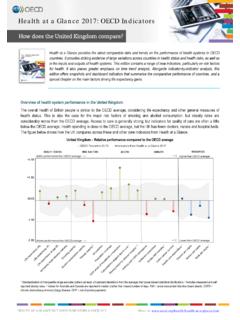Transcription of NIAMH - CHEX
1 :Mental health Promotion: Building an Economic CaseLynne Friedli & Michael ParsonageNIAMHN ovember 2007 Foreword (Chair, NIAMH ) 5 Summary Introduction Promoting better mental health 0 2. Policy context What is positive mental health ? Rationale for mental health promotion 4 Economic evaluation 5 Constraints and limitations Benefits of mental health promotion 8 3. Benefits of preventing mental illness 9 Benefits of promoting positive mental health Outcomes associated with positive mental health 25 Lifetime benefits Conduct disorder Effectiveness, cost-effectiveness and priorities 34 4. Parenting skills and pre-school education 35 health promoting schools 38 Employment/workplace 4 Lifestyle (diet, exercise, alcohol) 43 Environment 47 Conclusions 49 References 5 Contents3:4:Mental health Promotion: Building an Economic Case is the third policy document in a series commissioned by NIAMH .
2 The second paper, Counting the Cost produced with consultative input from the Sainsbury Centre for Mental health presented an estimate of the economic and social costs of mental illness in Northern Ireland which amounted to nearly 3 billion in the year 2002-03, more than outweighing the total spend on all health and social care for all health conditions. On any reckoning the costs of mental ill- health and hence the potential benefits of prevention are extremely high partly because of the widespread occurrence, partly because of its typically early manifestation and persistence throughout the life span and partly because of the mult-dimensional nature of its consequences. The treatment of many clinically diagnosed mental disorders is of limited report, produced by Lynne Friedli and Michael Parsonage, uses economic analysis to develop the case for greater investment in mental health promotion, defined as both the prevention of mental illness and the promotion of positive mental report demonstrates that the potential scale of economic benefits of preventing mental illness is commends the analysis, conclusions and recommendations of this report to those charged with deciding on the allocation of scarce resources to the greatest benefit over time to the population of Northern Graeme McDonaldChairmanNI Association for Mental HealthForeword5:6: Mental health problems have very high rates of prevalence.
3 They are often of long duration, and have adverse effects on many areas of people s lives, including educational performance, employment, income, personal relationships and social participation No other health condition matches mental ill- health in the combined extent of prevalence, persistence and breadth of impact Mental health problems often begin early in life and cause disability when those affected would normally be at their most productive (unlike most physical illnesses). The scope for securing benefits by means of treatment, rather than prevention, appears to be distinctly overall cost of mental health problems in Northern Ireland (2002/03) is estimated at billion (larger than the total amount spent by the NHS in Northern Ireland on all health conditions combined in 2002/03 and equivalent in monetary value to .7% of Northern Ireland s GDP in that year). Updating these figures and including figures for England, Scotland and Wales, it is calculated that the overall cost of mental health problems in the UK amounted to over 110 billion in 2006/07.
4 Northern Ireland s share of the total is put at around billion, reflecting a prevalence rate for mental health problems which is 20 25% higher than in the rest of the UK. The cost of mental illness is also very large relative to other health conditions, accounting for more disability adjusted life years (DALY) lost:Improving mental health , promoting the circumstances, skills and attributes associated with positive mental health is a worthwhile goal in itself: most people place a high value on a sense of emotional and social wellbeing. In addition, positive mental health also: contributes to preventing mental illness leads to better outcomes, for example in physical health , health behaviours, educational performance, employability and earnings, crime reduction. These beneficial outcomes are not just the result of the absence of mental illness. They are due wholly, or in some degree, to aspects of positive mental health .
5 Although there are many gaps in the data, the economic benefits of improving positive mental health may be extensive. For example, subjective well-being increases life expectancy by years, provides a similar degree of protection from coronary heart disease to giving up smoking, improves recovery and health outcomes from a range of chronic diseases ( diabetes) and in young people, significantly influences alcohol, tobacco and cannabis use. Positive affect also predicts pro-social behaviour participation, civic engagement and volunteering. While the best outcomes are generally associated with the absence of mental illness, the presence of positive mental health brings additional benefits, including for people with mental health scale of the economic benefits of preventing mental illness is considerable:Summary A tendency to be cheerful, energetic and to experience positive moods; sometimes referred to as a positive report uses economic analysis to develop the case for greater investment in mental health promotion, defined as the prevention of mental illness and the promotion of positive mental health .
6 Figures for England suggest that spending on mental health promotion is less than % of all NHS and local authority expenditure on mental health and may be less than % of all public spending on health promotion activity comparison, the costs of intervention are very low, ranging from 350 to 6000 per child for parenting programmes. Substantial investment in these programmes is therefore justified even if their effectiveness is limited, given the size of potential benefits relative to costs. A range of evidence indicates that success rates at the level required can be achieved in real life settings. For this reason, the report recommends investment in support for parents as the top priority in the provisional list of best buys in promoting mental health , as follows: Supporting parents and early years: parenting skills training/pre-school education Supporting children and young people: health promoting schools and continuing education Improving working lives: employment/workplace Positive steps for mental health : lifestyle (diet, exercise, sensible drinking and social support) Supporting communities: environmental improvementsAlthough the evidence is incomplete in some cases, these areas of intervention appear to offer the most favourable balance of effectiveness, scale of potential benefit and likely cost of implementation.
7 They demonstrate that all sectors have a role to play in improving mental health and the need for interventions that involve individuals and communities, but also those that address structural barriers to mental health and illness (including suicide) Cardiovascular disease to its importance as a health problem, spending on mental health is disproportionately low. Shown as a percentage of public expenditure on all health and social care, the figures are:England .8%Scotland . %Northern Ireland example of a common mental health problem for which there is robust evidence of effective interventions is conduct disorder. According to new estimates presented in the report: Preventing conduct disorders in those children who are most disturbed would save around 50,000 per case in lifetime costs Promoting positive mental health in those children with moderate mental health would yield benefits over the lifetime of around 75,000 per caseFor Northern Ireland, the total value of prevention in a one year cohort (23,000 births) would be million, with the total value of promoting positive mental health amounting to million.
8 7:8:Although there is now a much greater policy focus on positive mental health and well-being, there is still a great deal to do. There is a need for more consistent definition and measurement of mental health , to untangle the many different influences on mental well-being and to improve data on both the effectiveness and cost-effectiveness of interventions. New measures validated for use in the UK, for example the Warwick and Edinburgh Mental Well-being Scale (WEMWBS), will be of considerable value in providing a more complete picture of the mental health of the population. Nevertheless, even on the basis of existing data, the evidence summarised in this report demonstrates a very strong case for greater investment, not only in the prevention of mental illness but also in the promotion of positive mental health . The aim of this report is to analyse the case for mental health promotion from an economic perspective.
9 Developing the economic case for mental health promotion is a challenging undertaking. It raises a number of complex methodological problems and the extent of published evidence on the cost-effectiveness of different interventions is extremely limited, even drawing on international as well as UK studies. On the other hand, the wider (non-economic) literature on mental health promotion is now very substantial. Although some major gaps remain, there is increasing evidence of scope for effective action and its potential benefits. Using a variety of methods to add an economic component to the wider evidence base, this report explores two main issues: the general case for mental health promotion and possible priorities in the choice between interventions. For a variety of reasons the findings set out in this report are less clear-cut than those given in Counting the cost. The limited and provisional nature of the conclusions will be emphasised throughout.
10 It is nevertheless possible to identify some clear messages which we hope will be of value to the intended audience of policy makers and practitioners, particularly in stimulating debate and raising awareness. The report should not be seen as a contribution to academic was commissioned by the Northern Ireland Association for Mental health ( NIAMH ) and is intended to complement an earlier publication, Counting the cost: the economic and social costs of mental illness in Northern Ireland, published by NIAMH in collaboration with the Sainsbury Centre for Mental health ( NIAMH 2004). It should also be read in conjunction with a report on mental health promotion, Mental health improvement and well-being a personal, public and political issue, prepared for the Bamford Review of Mental health and Learning Disability (Northern Ireland) by a committee chaired by Professor Alan Ferguson, Chief Executive of NIAMH (DHSSPS 2006b).






